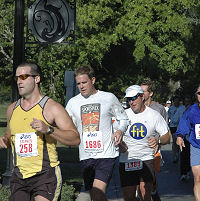To Cross-Train or to Not Cross-Train? By Susan Paul, MS , TSF Program Director

The theory behind cross-training is to provide a broader aerobic base through multi-sport training, increase the frequency of training by adding a variety of exercise modalities (especially non-weight bearing options), increase muscular strength and endurance, and improve upon any muscle group imbalances. Ideally, cross-training leads to a more thoroughly fit, well-rounded athlete which translates into improved race performance and a reduced risk of injury.
Many athletes have used cross-training methods for years; weight training being the most frequently used form of cross-training. The sport of triathlon demands cross-training as athletes train for 3 events simultaneously. Runners can benefit from cross-training if they follow some basic guidelines. These guidelines are designed to help you determine if cross-training would be useful to you or not, and more specifically, what
types of cross-training activities may be best given your fitness goals.

First, list your fitness goals. Listing your goals, in the order of importance, will help you decide what is MOST important to you. Establishing your primary goal is of utmost importance. Determining your primary goal will set the stage for what type of cross-training, if any, you should do. Do you want to run a marathon, or do a triathlon, perhaps set a PR in a 5K, lose weight, or improve your overall fitness? Your primary goal will also help set the intensity for the level of your cross-training. For example, if your goal is to run a marathon and you are also spinning on your non-run days, remember that the marathon is your primary goal, NOT the spin class. Keep the intensity of the spin class easy to moderate. It’s OK to pass on some of the jumps or to keep your resistance lighter than the rest of the class because you are going to be running 18 miles Saturday, are they? Don’t let your ego do you in! On the other hand, if you are training for a triathlon then spin class may not take precedence over your running. When triathlon training, some run days will be intense and the spin class easy, other days the spin class will be intense and the run easy.
Second, what type of cross-training do you want to do? Cross-training should assist your primary goal. For example, most runners need to develop more upper body strength and improve their flexibility. Weight training, swimming, yoga, and stretching are all forms of cross-training that would benefit runners. Spinning and cycling may not be as useful to a runner already logging lots of miles. Spinning or cycling, even at a lesser intensity, uses the same muscle groups as running and may not allow a long distance runner adequate recovery time between runs.
Decide which activity or activities would be best to add to your routine. Ask yourself :
- Do I need to build more muscle strength?
- Do I need more cardio stimulation without pounding the pavement?
- Do I want to burn more calories to assist weight loss?
Third, establish a REALISITC training routine. What days are you going to run? What days are you going to cross-train? Do you have one day a week OFF from all training? Have you included rest days, recovery days, and hard days in your training plan? Will adding cross-training to your routine mean exercising EVERY day of the week? Is this a realistic expectation? Be very realistic as you establish a routine; over-extending yourself sets you up for failure before you even begin. Take into account your work schedule, family, religious, and any other obligations you may have and plan a realistic schedule you can keep!
 Another general rule of thumb is to be FLEXIBLE with your routine. Many runners like the structure of doing something every day. Make this desire for routine and structure work FOR you rather than AGAINST you! If you have established a routine of running 3 days a week, spinning 2 days a week, and weight training 2 days a week, be prepared to make some changes within this routine. Alter the intensity of the spin classes by easing up on the resistance as your mileage builds or race day approaches. Target your upper body when weight training; especially when long runs are above 14 miles. Developing upper body strength is essential to maintaining good running posture. Doing a long run, or a race, a day or two after performing squats, lunges, and leg presses is not fun.
Another general rule of thumb is to be FLEXIBLE with your routine. Many runners like the structure of doing something every day. Make this desire for routine and structure work FOR you rather than AGAINST you! If you have established a routine of running 3 days a week, spinning 2 days a week, and weight training 2 days a week, be prepared to make some changes within this routine. Alter the intensity of the spin classes by easing up on the resistance as your mileage builds or race day approaches. Target your upper body when weight training; especially when long runs are above 14 miles. Developing upper body strength is essential to maintaining good running posture. Doing a long run, or a race, a day or two after performing squats, lunges, and leg presses is not fun.
The down side of cross-training is that we can overuse certain muscle groups which will slow down recovery time, and increase our risk of injury. For example, spinning uses the same muscle groups as running even though it is non-weight bearing. Using the same muscle groups over and over may not allow adequate recovery time even when we decrease the intensity of the exercise!
How can you tell if you have not adequately recovered between workouts?
- Lack of zest for training...you may not be allowing yourself adequate recovery time.
- Do you find yourself turning off the alarm clock and wishing for more sleep?
- Are you talking yourself out of workouts or finding reasons not to go to the gym?
One way to assess your recovery is to measure your resting heart rate. Obtain a baseline measurement of your resting heart rate by taking your pulse every morning at the same time. Record this measurement in your training log. You will see an average or a baseline trend that is your norm. If you take a pulse count and find it above your
baseline by 8 beats or more, take notice. A higher than normal resting heart rate may indicate lack of recovery, stress, over training, or an illness. Give yourself permission to take off and rest until your heart rate returns to its normal baseline.

WEIGHT TRAINING can be another very effective cross-training tool. Runners should place the emphasis of their weight training on their upper body muscles rather than their legs. Legs weights may be useful to work on known muscle imbalances, but as a general rule focus on your upper body. Use an endurance weight routine of 3 sets of 15 repetitions rather than a strength weight routine. Marathon runners, at five to six weeks out from your race, completely stop all leg work and at two to three weeks out stop all weight training.
EXERCISE CLASSES like Yoga, Pilates, or Boot Camp can also prove helpful to runners. These classes generally work on strengthening core postural muscles and improving flexibility which are both essential for runners. Runners need to be careful to avoid injury in these classes by doing too much too soon. All too often the runner mentality is to take the advanced class because, after all, we run marathons, don’t we? We aren’t really “Beginners”! Unfortunately, despite our advanced cardiovascular fitness we are beginners when it comes to muscle strength and flexibility!!
GENERAL CROSS-TRAINING RULES
1. Select cross-training modalities that will complement your primary goal.
2. Allow yourself at least one rest day a week.
3. Keep intensity easy to moderate on all forms of exercise- except your primary goal.
4. Alter the intensity of cross-training exercises as mileage builds, especially when long runs go above 14 miles.
5. Stop cross training 2-3 weeks out from race day.
6. Most importantly, ENJOY yourself!
Use Facebook to Leave a Comment - We'd love to hear from you.







